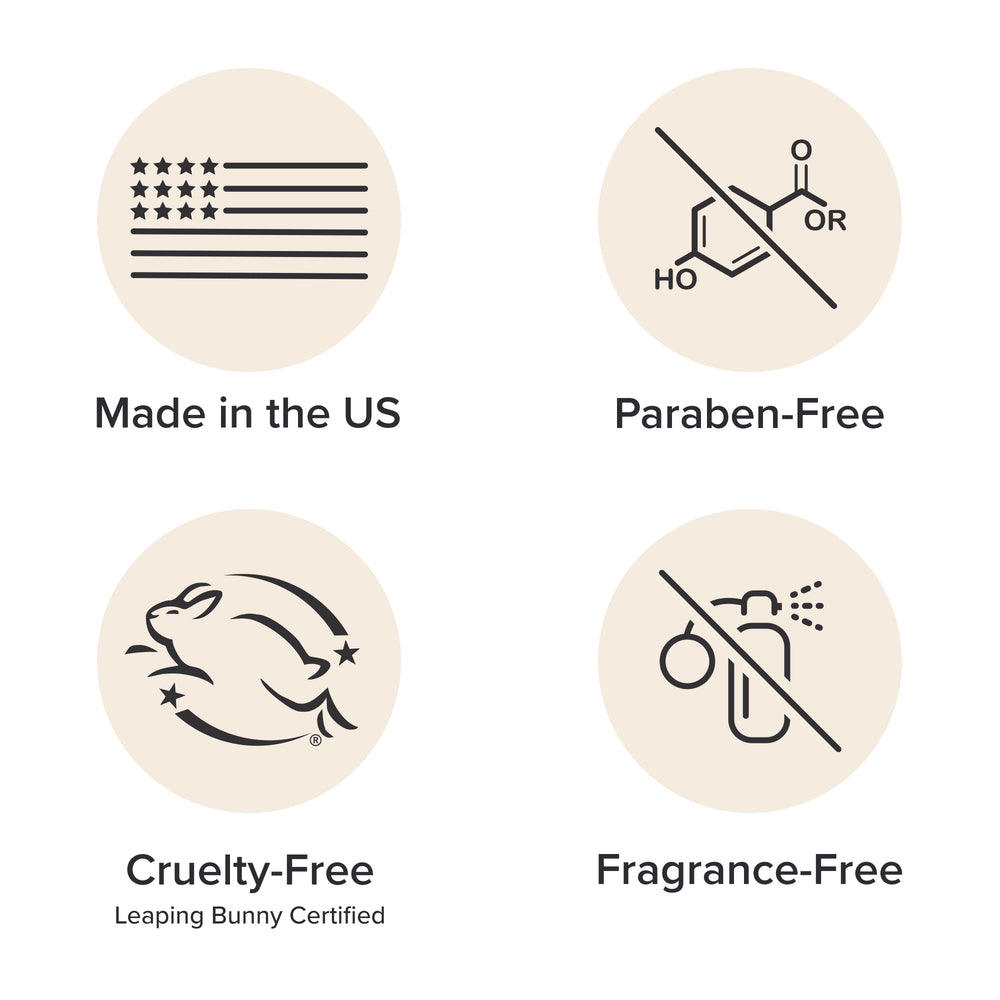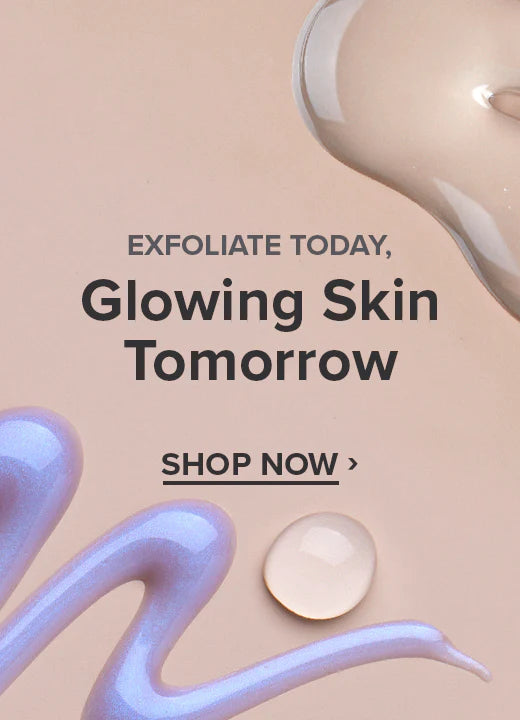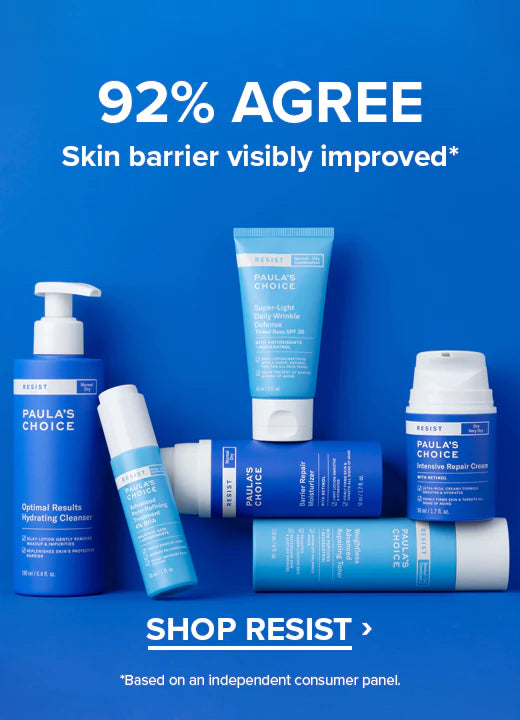Wrinkles: Causes, Prevention & Treatment
Written by: Shannon Steck
Medically Reviewed by: Dr. Corey L. Hartman MD Board-Certified Dermatologist
It’s a universal truth that with age, comes wrinkles. Some types of wrinkles, such as expression lines, are inevitable; others, mostly those from unprotected exposure to UV light, are preventable and, to a certain extent, repairable.
Brands have long promised to turn back skin's clock with elixirs, creams, lotions and serums. Within the last few decades, we’ve also seen surgical procedures, muscle-relaxing injectables and fillers enter the anti-aging sphere, promising to zap away evidence of aging and wrinkles in a blink. In-office procedures are typically a sure bet, but what about skin care for wrinkles?
We’re outlining everything from what causes wrinkles to the skin care products, ingredients and procedures that can actually help you tackle the look of wrinkles and fine lines so you won’t be disappointed or waste your money.
What are wrinkles?
Wrinkles are a natural and normal part of aging. They’re folds, lines or deeper furrows on the face and body that often fall into three main categories: dynamic wrinkles, static wrinkles and wrinkle folds.
Wrinkled skin often appears on the face first, due to a combination of more sun exposure and the constant movement facial expressions demand. Although most associate skin wrinkles with the face, they can appear anywhere on the body, usually popping up in places that receive the most sun: the back of the hands, neck and chest. Other areas where wrinkles develop and drive people crazy are the upper arms, around the knees and the buttocks.
Note: although it’s true that wrinkles are a natural part of getting older, how much and how deeply your skin wrinkles is largely within your control—and that’s exciting!
Dehydration lines vs. wrinkles
The myth about dry or dehydrated skin causing wrinkles persists because dry or dehydrated skin looks more wrinkled than skin that isn't. It’s that simple.
When skin's dry or dehydrated (dry skin lacks oil and ceramides; dehydrated skin lacks water), it’s deprived of a vital substance it needs to function in a healthy matter. This deficit of oil or water can cause what some call “dehydration lines.” These aren’t new fine lines and wrinkles that suddenly appear, but are fine lines and wrinkles that are accentuated when skin lacks what it needs to be healthy. These types of wrinkles due to dry or dehydrated skin can easily be remedied with nourishing and hydrating skin care products.
Relieving signs and sensations of dry skin means incorporating emollient, hydrating ingredients, like non-fragrant plant oils, such as argan oil and evening primrose oil, plant butters (think shea butter) and skin-replenishing ingredients into your skin care routine.
Dehydrated skin requires a slightly different approach. Unlike dry skin, it’s not a skin type, but a fleeting condition that’s brought on by external factors. You might need to do some detective work to see precisely what’s causing the dehydrated skin. Assess your skin care products: do any of them contain potentially irritating ingredients like fragrance, essential oils and denatured or SD alcohol? If so, seek out irritant-free alternatives. If that’s not the root cause, make sure you’re not using any abrasive physical scrubs, products or tools, like cleansing brushes. These can disrupt and go on to impair the skin barrier, making it more prone to water loss, especially in dry environments.
After some detective work in finding the “trigger” of the dehydrated skin, add products with hydrating humectants into your skin care routine, like a hyaluronic acid booster, which helps skin attract and trap moisture. It’s important to understand that dehydrated skin can also occur in those with oily skin.
What causes wrinkles?
Endless studies refer to the causes of skin aging and wrinkles as being either “extrinsic” or “intrinsic”. Extrinsic refers to external things in the environment and intrinsic factors are those things happening in the body over many years that eventually impact skin’s appearance.
Extrinsic aging is primarily about sun damage from unprotected sun exposure, but it also includes environmental assaults such as ongoing exposure to pollution and smoking (including exposure to secondhand smoke). This is exceedingly bad for skin in both the short term and long term; it’s a leading factor in what causes wrinkled skin. Unmitigated exposure to natural elements weakens skin’s structure, allowing for wrinkles to stake their claim. Of course, consistent application of SPF 30+ and usage of antioxidant-rich skin care products can help lessen the extent to which extrinsic damage shows up on our skin.
Intrinsic aging involves various influences such as repetitive muscle movement (that’s why those smile and frown lines set in and show up first), midlife changes impacting skin’s supportive elements, fat depletion, fat loss and fat pad movement, and illness.
Skin care practices can also impact the appearance of wrinkles and fine lines! Long-term usage of fragranced products and skin-sensitizing ingredients can worsen the appearance of wrinkles and fine lines.
Can stress cause wrinkles?
Stress can cause wrinkles. This might sound shocking, but it’s true!
This is because stress contributes to the creation of a substance that chips away at skin’s underlying structure- the same structure that keeps skin firm and elastic. Beyond wrinkles, chronic stress can also contribute to other factors that make skin appear older, like redness, irritation and uneven tone.
Stress management is a healthy solution that has far-reaching benefits, including those beyond skin aging. A great way to try to reduce your stress levels is daily meditation.
Does makeup cause wrinkles?
Makeup can’t directly cause wrinkles, but the ways that it’s applied and removed can cause damage that eventually leads to skin aging or make the wrinkles you have more apparent.
Much like with skin care products, it’s important that your makeup products are fragrance- and irritant-free. A fragranced concealer applied to the delicate skin under the eye can cause irritation that eventually leads to visible signs of aging.
When applying and removing makeup (especially eyeliner!), it’s best practice to not pull skin taut. Daily tugging, pulling and manipulating for the sake of a cat-eye won’t spur wrinkles in the short-term, but in the long-term it compromises and stretches the substances that allows our skin to “bounce back”. Voila, you’ve got another wrinkle.
Now let’s touch on the biggest makeup no-no of all, sleeping in a full face. Not properly removing makeup and cleansing can lead to the formation of bumps, clogged pores, puffiness and irritation. If sleeping in a full face is your calling card, you might want to create a new habit, as it could potentially contribute to the look of skin aging.
How to prevent wrinkles
Preventing wrinkles and fine lines requires a multipronged approach. Before we go into the non-skin care practices you can incorporate into your day-to-day life to reduce the likelihood of wrinkles, we need to bust the myth that wrinkles can be completely prevented. This simply isn’t true. Not all wrinkles can be avoided!
Wrinkles that stem from extrinsic aging can be prevented. We can even impact how our intrinsic aging plays out on our skin, but the truth is: not all wrinkles can be prevented.
Now, let’s get into the best non-skin care ways to reduce the appearance of wrinkles and fine lines:
- Consistent broad-spectrum SPF 30+ usage and sun avoidance when possible.
- Stress reduction through management techniques (meditation, yoga, lifestyle changes).
- Avoiding smoking, vaping and secondhand smoke.
- Consuming nutrient-dense and antioxidant-rich foods.
Does moisturizing prevent wrinkles?
Using moisturizers that contain only hydrating ingredients can’t help in the prevention of wrinkles, but this type of moisturizer can help nourish skin that’s dry and dehydrated, in turn lessening the appearance of the aforementioned “dehydration lines” by helping to restore a smooth, supple look and feel.
Preventing wrinkles through moisturizing requires a moisturizer or wrinkle cream formulated with a cocktail of hydrators, antioxidants and other bio-active anti-aging powerhouses, like retinol and niacinamide. Bathing skin in a mixture of ingredients not only allows it to behave in a healthy, youthful manner, but also helps defend against extrinsic aging factors that cause fine lines and wrinkles. Maintaining the integrity of the skin barrier through moisturizers containing emollient ingredients like ceramides, petrolatum, squalene and glycerin also help to trap moisture and avoid the development of wrinkles.
The best anti-aging moisturizer? An antioxidant-rich moisturizer with SPF. This approach provides layers of protection from harmful external environmental aggressors that can impact skin aging, including pesky UV rays.
How to treat wrinkles
Sunscreen is the #1 anti-aging skin care product you can apply, and should be applying, every day (but you already knew we were going to say that right?). Exposure to UV rays can cause early skin aging, as well as further damage, like burns, uneven tone and chronic inflammation. Daily use of broad-spectrum sunscreen rated SPF 30 or greater can absolutely reduce the risk of early signs of skin aging by helping to prevent this damage.
On top of SPF, when it comes to what supporting anti-aging skin care products to choose, it’s never as simple as what one ingredient or product can provide. That’s why in addition to sunscreen, research shows that the best defense is a gentle, complete skin care routine enriched with antioxidants, skin- replenishing ingredients, skin-soothing ingredients and skin-restoring ingredients.
Here are some of our favorite anti-aging skin care superstar ingredients and wrinkle products that you should include in your routine:
- Exfoliants, like AHA (alpha hydroxy acid) and BHA (beta hydroxy acid), prompt skin to shed dead, dull layers the way it did when it was younger, resulting in smoother skin with less visibly prominent wrinkles. Using a leave-on exfoliant is a great way to reap the benefits of AHA and BHA. Note: choose BHA if you also struggle with clogged, enlarged pores or oily skin. If you have dry, sun-damaged skin that is also sensitive, consider a lightweight liquid AHA exfoliant with a time-release formula that’s extra-gentle yet still effective.
- Vitamin C, skin care’s favorite antioxidant, mitigates the pro-aging damage that extrinsic factors can have on skin as well as supports the maintenance of skin’s underlying firm structure. Incorporating vitamin C into your routine is as simple as drenching your skin in moisturizers, serums or boosters enriched with this multi-tasking staple.
- Retinoids, including retinol, have long been hailed the “it” ingredients when it comes to anti-aging because they’re proven to minimize the look of wrinkles, improve uneven skin tone and reignite a feeling of firmness to skin (11). Paula’s Choice has a range of retinol products, making it easy to find one that fits with your skin type and needs.
- Antioxidants work to hinder extrinsic aging through assisting in the defense of skin from pollution, UV rays and other sneaky pro-aging external agents. They’re an asset in any anti-aging arsenal and often included in many skin care products, but our favorite way to use them is through concentrated serums.
- Peptides are an interesting group of ingredients that are amassing an impressive well of research proving their anti-aging abilities. When applied topically, they can reduce the look of fine lines and wrinkles, firm, plump, smooth and work to improve skin’s underlying support structure. If this sounds up your alley, the Pro-Collagen Multi-Peptide Booster contains a highly specialized blend of six peptides for targeted anti-aging benefits.
Prescription-strength retinoids like tretinoin are also sought-after when it comes to anti-aging. These higher-strength forms of vitamin A have the same benefits of retinol and OTC (over-the-counter) retinoids, including reducing the appearance of wrinkles and assisting in evening skin tone. The difference is that the prescription forms work faster but come with the tradeoff of irritation some people can’t tolerate.

Beyond skin care, surgical intervention as well as injections, peels and lasers and other energy-based devices can address more stubborn, deeper wrinkles and fine lines. Face lifts, a surgical procedure wherein a doctor manually lifts, sutures and tightens the skin and underlying structure of the face offers more dramatic visible results that can last a decade or so.
Less invasive procedures to prevent and address aging are becoming more popular as their accessibility increases. Injectable neuromodulators, like botulinum toxin (AKA its branded version Botox®) lessen muscle’s mobility, smoothing wrinkles associated with repeated facial expressions. Injectable fillers, hyaluronic acid the most popular amongst these, “fill” the deep lines and folds that appear on the face, most commonly around the mouth and chin. Hyaluronic acid fillers and Botox® aren’t permanent and must be kept up with to maintain results. Generally, you can expect both to last for 4–6 months before another neuromodulator treatment is needed, while fillers can last anywhere from 1-3 years depending on the product.
Non-injectable anti-aging treatments like resurfacing lasers and chemical peels assist in ridding the skin of signs of damage often associated with UV rays, such as dark discolorations and rough texture. They too need to be carried out by a licensed professional and multiple treatments are needed for optimal results.
Do I need multiple treatments to get rid of wrinkles?
An army of internal and external factors cause and can worsen wrinkles. Using a single treatment option, product or path of action won’t rid skin of the appearance of wrinkles any more than eating one healthy food makes for a wise diet.
Preventing and helping to visibly repair wrinkles requires a well-rounded approach that includes a skin care routine rich in beneficial and soothing ingredients, healthy lifestyle choices and a dedication to daily sun protection. Even if you seek out non-topical options like surgery, fillers or injectables, they must be kept up with and supported with the above.
Board-certified dermatologist Dr. Corey L. Hartman notes, “ In-office procedures without a solid skin care regiment to back them up are not as effective in the long term.” Would you want to waste all the time, effort and money you put into these procedures for wrinkles and fine lines to reappear due to spending too much time in the sun without SPF? No way.
Are there side effects to wrinkle treatment options?
When it comes to prescription-strength retinoid creams, dryness, peeling, flaking and sensitivity can occur and may persist unless you stop using the product. It’s important to never skimp on the SPF when applying these retinoids and to seek out moisturizers with a mix of humectants and emollients for optimal hydration. Generally, retinol and many of its derivatives as used in skin care are better tolerated, although some people find they cannot use OTC versions, either.
Dr. Hartman points out, “ Identifying your skin type and matching products is imperative to constructing a winning skin care regimen and highlights the importance of an individualized approach. Just because it worked for your friend, doesn’t mean that it’s right for you.”
Surgeries and procedures, like injectables and fillers, also have side effects attached to them. For more insight into these, "seek out the advice of your dermatologist or plastic surgeon”, according to Dr. Hartman.
Does drinking water help your skin for wrinkle treatment?
Let’s jump right to the chase here: drinking water doesn’t help rid skin of wrinkles. This idea comes from the notion that having a minimum of 8 glasses of water a day keeps skin hydrated.
As we touched on before, it’s believed that properly hydrating skin will prevent or eliminate wrinkles. To reiterate, this isn’t true. Keeping skin hydrated only reduces the appearance of dehydration lines.
Now, let’s tackle the idea that drinking water keeps skin hydrated. For a long time, this idea was completely unsupported. However, in 2015 a study concluded that drinking one gallon (not 8 glasses!) of water a day increased skin hydration.
If you’re that dedicated to your water consumption, feel free to chug a gallon a day to help keep the dryness away. We’ll keep to moisturizing and save ourselves extra trips to the bathroom!
Learn more about anti-aging & wrinkles.
References for this information:
- Journal of the Mechanical Behavior of Biomedical Materials, May 2020, ePublication
- Electronics, February 2021, ePublication
- Skin Research and Technology, February 2018, pages 386-395
- Dermato-Endocrinology, July 2012, pages 308-319
- The Journal of Clinical and Aesthetic Dermatology, August 2019, pages 28-39
- Journal of Cosmetic Dermatology, February 2020, pages 444-455
- Advanced Pharmaceutical Bulletin, August 2019, pages 348-359
- Journal of Clinical Medicine, November 2022, ePublication
- Plants, January 2022, ePublication
- Scientific Reports, October 2020, ePublication
- Skin Research and Technology, June 2022, pages 604-613
- Bulletin of Experimental Biology and Medicine, June 2016, pages 175-178
- ChemMedChem, November 2015, pages 1850-1855
- Clinical Cosmetic Investigative Dermatology, August 2015, pages 413-421





